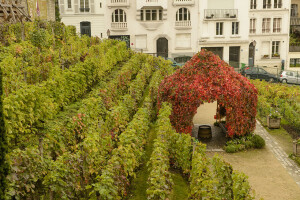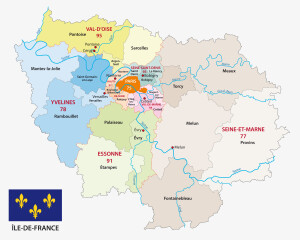On May 25, 2020, France’s Bulletin Officiel du Ministère de l’Agriculture et de l’Alimentation (Official bulletin of the Ministry of Agriculture and Food) announced the approval of the Île-de-France Protected Geographical Indication (PGI) for red, white, and rosé wines.
Wine produced from grapes grown anywhere within the Île de France administrative region will be eligible. Aisne, a department located in the neighboring Hauts-de-France region is also included in the defined area. More specifically, the Île de France PGI includes five sub-appellations:
- Coteaux de Blunay—covering the commune of Melz-sur-Seine, located on the eastern border of the Île de France (about 50 miles southeast of Paris)
- Coteaux de Suresnes-Mont-Valérien—Suresnes is a commune in the western suburbs of Paris, located about 9 km/5.3 miles from the Paris city center
- Coteaux de Provins—covering the commune of Provins, located about 10 miles northwest of Melz-sur-Seine
- Guérard—covering the communes of communes de Guérard, Tigeaux et Crécy-la-Chapelle (located about 28 miles west of Paris, and just a few miles from Disneyland Paris)
- Paris—covering the city of Paris, including its famous Montmarte Vineyard
A long list of grape varieties are permitted—33 white varieties, 8 pink (gris/rose) varieties, and 30 red varieties. Most or all of the grapes you would think of as typical French varieties—including Chardonnay, Pinot Noir, Chenin Blanc, Gamay, Merlot, Cabernet Sauvignon, and Sauvignon Blanc—are included in the list. Some unique grapes—such as Meslier Saint-François, Chasselas, Mûller-Thurgau, Romorantin, and César. (For a complete list, see the Cahier des Charges, linked below.)
The Île-de-France PGI title is approved for still (non-sparkling) wines and includes allowances for primeur or nouveau wines to be released on the third Thursday of November (of the harvest year).
Wine-producing vineyards in and around the city of Paris were widespread in the 18th century and at one time occupied 42,000 hectares (103,000 acres) of land. These vineyards all but disappeared after the Second World War; but were brought back to life in 1933 with the planting of 2,00 vines in the Clos de Montmartre vineyard. Clos de Montmartre—the famous “urban vineyard” of Paris—is located on the north side of the Hill of Montmartre just a short walk from the Basilica of Sacré-Cœur de Montmartre.
Later—in 1965—the Municipal Vineyard of Suresnes/Clos-du-Pas Saint Maurice was replanted on the crest of Mont-Valérien, just across the Seine River from the Bois de Boulogne Park in Paris’ 16th arrondissement. Today, the vineyard produces an average of 4,500 bottles of white wine per year and is an under-the-radar “find” for smart (or lucky) tourists.
With this announcement, we can be certain to find PGI wines from the Île-de-France in our local neighborhood wine shops soon (that is, as long as your local neighborhood wine shop is located somewhere in or close to Paris).
Welcome to the World, Île-de-France PGI!
References/for more information:
- Cahier des Charges IGP Ile de France
- https://info.agriculture.gouv.fr/gedei/site/bo-agri/historique/28-05-2020
- https://www.vitisphere.com/news-88788-Paris-has-its-own-geographical-indication.htm?fbclid=IwAR3TEfLuOoIQOOAUgtxw22ywHKQBPWof_smZ6Wm6ZcZRG4pefZA0U1_Vz_8
- https://france3-regions.francetvinfo.fr/paris-ile-de-france/paris/grand-paris/vins-franciliens-obtiennent-enfin-indication-geographique-protegee-1788151.html?fbclid=IwAR3VLDWxKIYzeXWimVh8pCu4FSsq_9xEM-JUr5N4WABKHr4t1lS0tkA4AR8
- https://www.paris-bistro.com/vin/bacchus-a-paris/vignerons-franciliens-reunis
- https://en.suresnes-tourisme.com/vineyard-of-suresnes.html
- https://fr.wikipedia.org/wiki/Vignoble_d%27%C3%8Ele-de-France
Post authored by Jane A. Nickles…your blog administrator: jnickles@societyofwineeducators.org

